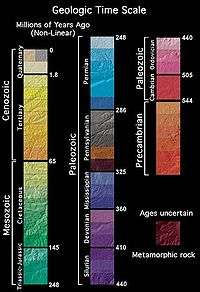United States physiographic region

USGS map colored by paleogeological areas and demarcating the sections of the U.S physiographic regions: Laurentian Upland (area 1), Atlantic Plain (2-3), Appalachian Highlands (4-10), Interior Plains (11-13), Interior Highlands (14-15), Rocky Mountain System (16-19), Intermontane Plateaus (20-22), & Pacific Mountain System (23-25)

The legend of paleogeological color also depicts topographic terrain.
Main articles: Geography of the United States and Physiographic regions of the world
This list of physiographic regions of the contiguous United States identifies the 8 regions, 25 provinces, and 85 sections.[1] The system dates to Nevin Fenneman's paper Physiographic Subdivision of the United States, published in 1917.[2] Fenneman expanded and presented his system more fully in two books, Physiography of western United States (1931),[3] and Physiography of eastern United States (1938).[4] In these works Fenneman described 25 provinces and 85 sections of the United States physiography.[5]
Physiographic divisions
References
- ↑ "Physiographic Regions". United States Geological Survey. 2003-04-17. Retrieved 2008-01-30.
- ↑ Fenneman, Nevin M. (January 1917). "Physiographic Subdivision of the United States". Proceedings of the National Academy of Sciences of the United States of America 3 (1): 17–22. doi:10.1073/pnas.3.1.17. OCLC 43473694. PMC 1091163. PMID 16586678. Retrieved 5 October 2010.
- ↑ Fenneman, Nevin Melancthon (1931). Physiography of western United States. McGraw-Hill. OCLC 487636.
- ↑ Fenneman, Nevin Melancthon (1938). Physiography of eastern United States. McGraw-Hill. OCLC 487628.
- ↑ "Automated IFSAR Terrain Analysis System". Defense Advanced Research Projects Agency (DOD), Information Sciences Office. 31 August 2001. Retrieved 5 October 2010.
| ||||||||||||||||||||||||||||||||||||||||||||||||||||
This article is issued from Wikipedia - version of the Monday, September 01, 2014. The text is available under the Creative Commons Attribution/Share Alike but additional terms may apply for the media files.